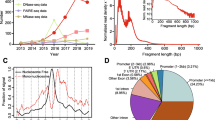Abstract
ATAC-seq (Assay for Transposase-Accessible Chromatin using sequencing) has gained wide popularity as a fast, straightforward, and efficient way of generating genome-wide maps of open chromatin and guiding identification of active regulatory elements and inference of DNA protein binding locations. Given the ubiquity of this method, uniform and standardized methods for processing and assessing the quality of ATAC-seq datasets are needed. Here, we describe the data processing pipeline used by the ENCODE (Encyclopedia of DNA Elements) consortium to process ATAC-seq data into peak call sets and signal tracks and to assess the quality of these datasets.
Access this chapter
Tax calculation will be finalised at checkout
Purchases are for personal use only
Similar content being viewed by others
References
Buenrostro JD, Giresi PG, Zaba LC et al (2013) Transposition of native chromatin for fast and sensitive epigenomic profiling of open chromatin, DNA-binding proteins and nucleosome position. Nat Methods 10:1213–1218. https://doi.org/10.1038/nmeth.2688
Galas DJ, Schmitz A (1978) DNAse footprinting: a simple method for the detection of protein-DNA binding specificity. Nucleic Acids Res 5:3157–3170. https://doi.org/10.1093/nar/5.9.3157
Hesselberth JR, Chen X, Zhang Z et al (2009) Global map** of protein-DNA interactions in vivo by digital genomic footprinting. Nat Methods 6:283–289. https://doi.org/10.1038/nmeth.1313
Li Z, Schulz MH, Look T et al (2019) Identification of transcription factor binding sites using ATAC-seq. Genome Biol 20:45. https://doi.org/10.1186/s13059-019-1642-2
ENCODE Project Consortium, Moore JE, Purcaro MJ et al (2020) Expanded encyclopaedias of DNA elements in the human and mouse genomes. Nature 583:699–710. https://doi.org/10.1038/s41586-020-2493-4
Martin M (2011) Cutadapt removes adapter sequences from high-throughput sequencing reads. EMBnet J 17:10. https://doi.org/10.14806/ej.17.1.200
Langmead B, Salzberg SL (2012) Fast gapped-read alignment with Bowtie 2. Nat Methods 9:357–359. https://doi.org/10.1038/nmeth.1923
Li H, Handsaker B, Wysoker A et al (2009) The sequence alignment/map format and SAMtools. Bioinformatics 25:2078–2079. https://doi.org/10.1093/bioinformatics/btp352
Quinlan AR, Hall IM (2010) BEDTools: a flexible suite of utilities for comparing genomic features. Bioinformatics 26:841–842. https://doi.org/10.1093/bioinformatics/btq033
(2020) Picard Toolkit. Broad Institute
Feng J, Liu T, Qin B et al (2012) Identifying ChIP-seq enrichment using MACS. Nat Protoc 7:1728–1740. https://doi.org/10.1038/nprot.2012.101
Kharchenko PV, Tolstorukov MY, Park PJ (2008) Design and analysis of ChIP-seq experiments for DNA-binding proteins. Nat Biotechnol 26:1351–1359. https://doi.org/10.1038/nbt.1508
Ramírez F, Ryan DP, Grüning B et al (2016) deepTools2: a next generation web server for deep-sequencing data analysis. Nucleic Acids Res 44:W160–W165. https://doi.org/10.1093/nar/gkw257
Amemiya HM, Kundaje A, Boyle AP (2019) The ENCODE blacklist: identification of problematic regions of the genome. Sci Rep 9:9354. https://doi.org/10.1038/s41598-019-45839-z
Avsec Ž, Weilert M, Shrikumar A et al (2021) Base-resolution models of transcription-factor binding reveal soft motif syntax. Nat Genet 53:354–366. https://doi.org/10.1038/s41588-021-00782-6
Meyer CA, Liu XS (2014) Identifying and mitigating bias in next-generation sequencing methods for chromatin biology. Nat Rev Genet 15:709–721. https://doi.org/10.1038/nrg3788
Henikoff JG, Belsky JA, Krassovsky K et al (2011) Epigenome characterization at single base-pair resolution. PNAS 108:18318–18323. https://doi.org/10.1073/pnas.1110731108
Author information
Authors and Affiliations
Corresponding author
Editor information
Editors and Affiliations
Rights and permissions
Copyright information
© 2023 The Author(s), under exclusive license to Springer Science+Business Media, LLC, part of Springer Nature
About this protocol
Cite this protocol
Kim, D.S. (2023). ATAC-seq Data Processing. In: Marinov, G.K., Greenleaf, W.J. (eds) Chromatin Accessibility. Methods in Molecular Biology, vol 2611. Humana, New York, NY. https://doi.org/10.1007/978-1-0716-2899-7_17
Download citation
DOI: https://doi.org/10.1007/978-1-0716-2899-7_17
Published:
Publisher Name: Humana, New York, NY
Print ISBN: 978-1-0716-2898-0
Online ISBN: 978-1-0716-2899-7
eBook Packages: Springer Protocols




